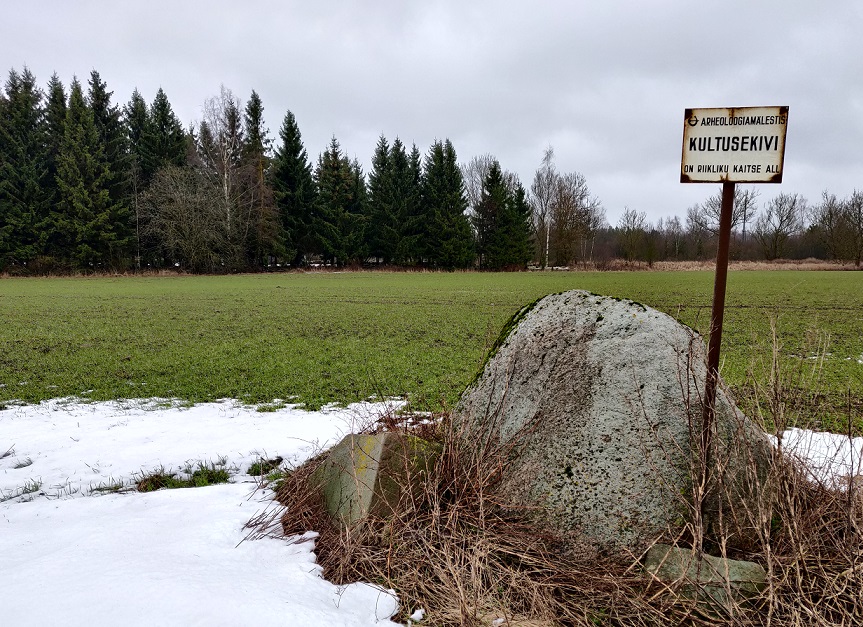Memories of ancient sacred groves and trees were preserved in folklore until the beginning of the twentieth century
Folk religion is the experience-driven belief of groups of people for which no separate institution has been created. Assumptions about the ancient religion of the Estonian tribes can be made on the basis of archaeological finds, linguistic history, and individual written sources. It was probably similar to the religion of other natural peoples, where animism and ancestral cult were central elements. They believed in the nature spirits, who could live in forests, trees, rocks or springs.

The characteristic feature of the Estonian folk religion was pluralism, which was manifested in the belief in many spirits and fairies who did not have a relationship of subordination – spirits embodied different areas of nature and their sphere of power was limited. Old Estonians believed in living nature, characteristically of animism [1].
The word ‘sacred’ could mean something untouchable, separated, and endless. Everything sacred radiated mystery and power dangerous to man and demanded ritualistic behaviour as a precaution. Places, objects, people, animals, periods of time, life events, various phenomena, and situations could be sacred. Examples of sacred sites were sacrificial rocks, springs, and sacred groves [1].
For the tribes on the Estonian territory, sacrificing was important as a ritual activity. People sacrificed to the souls of their dead ancestors, the spirits of nature, and the fairies to, for example, protect themselves from calamities and diseases or to receive good crops and good fortune. The sacrificial gifts were mainly food or drink, but also agricultural and livestock products, as well as money and jewellery. A particularly important sacrificial gift was hõbevalge – the silver specks scraped from silver coins or jewellery, which was thought to carry special power [1].
One of the most important places in the Estonian folk religion has always been hiis, a tree grove considered to be sacred. It usually consisted of deciduous trees (often oaks) and was located near a village on a higher hill, in an open plain, or near a depression or spring. Originally, the sacred grove was probably also a burial place. Dead ancestors were highly respected and every effort was made to gain their approval. This was accompanied by the sacredness of the sacred grove sites – in the sacred groves, you could not trample, break branches, pick anything, or fell any trees. Today, the same principle is applied to cemeteries and cross forests. Later, when sacred groves were no longer associated with the dead in folklore, sacrifices were made to the spirits living under the earth, fairies, and other supernatural forces believed to be living in the sacred grove or the sacred trees [1].
With Christianisation, the destruction of the sacred groves began. More specifically, the Catholic Church erected its crosses and chapels on top of the sacred sites, while the Lutheran Church tried to completely eradicate the custom of believing old groves and trees were sacred, as well as the custom of sacrifice. Despite all that, people still buried their dead in the sacred groves during the seventeenth and eighteenth century. The worship of sacred groves and sacred trees ceased at the beginning of the nineteenth century, while memories of ancient sacred sites and trees remained in folklore until the beginning of the twentieth century [1].
There are about 400 known sacrificial springs in Estonia, to which a magical healing effect has been attributed. For example, their water was used to treat eye and skin diseases and to cleanse bad deeds. Silver was sacrificed to the springs, which is why silverware dating back to the eighth to the twelfth century has been found from springs [1]. The practice of throwing coins in the springs still persists.
In Southern Estonia, the custom of cutting a cross into a tree while the funeral procession moves from the home of the deceased to the cemetery is still practised in some places. It was believed that by doing so, the soul of the deceased would find peace and would not become a restless ghost [2].
Last modified: 01.12.2021
__________________________________________________
[1] http://www.estonica.org/et/Kultuur/Rahvakultuur/Rahvausund/
[2] M. Torp-Kõivupuu. Ristipuud maastikul ja usundilises jutupärimuses. http://www.folklore.ee/tagused/nr27/torp.pdf